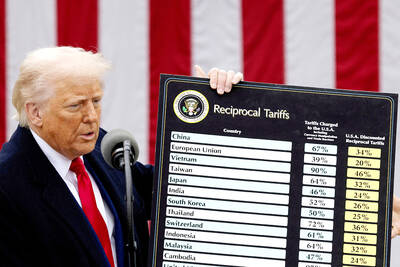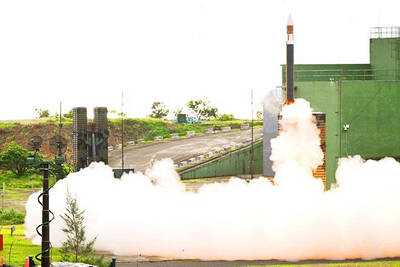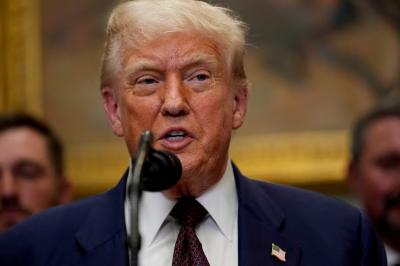The US dollar declined to the lowest level this year against six major US trading partners as optimism that a global recovery is near reduced demand for the greenback as a refuge.
The Swedish krona advanced against the euro to the strongest level since November after a government report on Friday showed the contraction in the Scandinavian country slowed last quarter. US Federal Reserve Chairman Ben Bernanke told Congress last month that policy makers will maintain a “highly accommodative” monetary policy for an extended period.
“It’s clear that the economy is recovering,” said Adam Boyton, a strategist in New York at Deutsche Bank AG, the world’s largest currency trader. “Ben Bernanke is making it clear that although he has an exit strategy, he’s not going to use it any time soon. That’s probably been a small negative for the dollar.”
The dollar fell 1.6 percent last month to US$1.4257 per euro in New York, from US$1.4033 on June 30. The US currency fell 1.7 percent to ¥94.68, from ¥96.36 a month earlier. The Japanese currency gained 0.2 percent this month to ¥134.99 per euro, the first advance in three months.
The Dollar Index, which the ICE futures exchange uses to track the currency against counterparts including the yen, pound and Swedish krona, touched 78.22 on Friday, the lowest since Dec. 18. The index dropped 2.3 percent in July.
The dollar declined 1.3 percent versus the euro on Friday, the biggest loss in a month, as a report showing the US economy shrank less than economists forecast added to signs the global recession may be ending, encouraging investors to buy higher-yielding assets overseas.
The Canadian dollar was the best performer among the major currencies, rising 7.9 percent versus the greenback, as stock gains and higher crude oil prices burnished the appeal of currencies linked to growth.
Canada’s currency touched C$1.075 against the greenback on Tuesday, the strongest level since Oct. 3, as crude oil reached US$69 a barrel. The currency ended the month at C$1.078 after a government report showed the nation’s economy shrank a more-than-forecast 0.5 percent in May.
South Korea’s won and Indonesia’s rupiah led gains in Asian currencies this week as overseas investors added to holdings of emerging-market assets on signs the global economy is recovering.
The Bloomberg-JPMorgan Asia Dollar Index, which tracks Asia’s 10 most-traded currencies outside of Japan, had a third weekly advance after Japanese and South Korean manufacturers increased production and South Korea posted a current-account surplus for a fifth month.
The won gained 1.7 percent to 1,228.42 per dollar in Seoul and the rupiah rose 0.5 percent to 9,950, data compiled by Bloomberg show. It reached 9,910 on Friday, the strongest since Oct. 24. The Asia Dollar index climbed 0.3 percent.
The won was the best-performing regional currency last month, while the Philippine peso was little changed and the Malaysian ringgit fell 0.1 percent. The Indian rupee traded at 47.9275 per dollar, a four-week high, from 48.2300 a week ago.
The New Taiwan dollar rose 0.4 percent in the past week to NT$32.818.
Elsewhere, the peso traded at 48.085 from 48.067 a week ago. The baht fell 0.1 percent to 34.01. It reached 33.88 on Tuesday, the highest level since Oct. 1, and is the third-best performing Asian currency outside Japan this year.
The ringgit climbed 0.3 percent this week to 3.5185 in Kuala Lumpur.

WAITING GAME: The US has so far only offered a ‘best rate tariff,’ which officials assume is about 15 percent, the same as Japan, a person familiar with the matter said Taiwan and the US have completed “technical consultations” regarding tariffs and a finalized rate is expected to be released soon, Executive Yuan spokeswoman Michelle Lee (李慧芝) told a news conference yesterday, as a 90-day pause on US President Donald Trump’s “reciprocal” tariffs is set to expire today. The two countries have reached a “certain degree of consensus” on issues such as tariffs, nontariff trade barriers, trade facilitation, supply chain resilience and economic security, Lee said. They also discussed opportunities for cooperation, investment and procurement, she said. A joint statement is still being negotiated and would be released once the US government has made

‘CRUDE’: The potential countermeasure is in response to South Africa renaming Taiwan’s representative offices and the insistence that it move out of Pretoria Taiwan is considering banning exports of semiconductors to South Africa after the latter unilaterally downgraded and changed the names of Taiwan’s two representative offices, the Ministry of Foreign Affairs (MOFA) said yesterday. On Monday last week, the South African Department of International Relations and Cooperation unilaterally released a statement saying that, as of April 1, the Taipei Liaison Offices in Pretoria and Cape Town had been renamed the “Taipei Commercial Office in Johannesburg” and the “Taipei Commercial Office in Cape Town.” Citing UN General Assembly Resolution 2758, it said that South Africa “recognizes the People’s Republic of China (PRC) as the sole

NEW GEAR: On top of the new Tien Kung IV air defense missiles, the military is expected to place orders for a new combat vehicle next year for delivery in 2028 Mass production of Tien Kung IV (Sky Bow IV) missiles is expected to start next year, with plans to order 122 pods, the Ministry of National Defense’s (MND) latest list of regulated military material showed. The document said that the armed forces would obtain 46 pods of the air defense missiles next year and 76 pods the year after that. The Tien Kung IV is designed to intercept cruise missiles and ballistic missiles to an altitude of 70km, compared with the 60km maximum altitude achieved by the Missile Segment Enhancement variant of PAC-3 systems. A defense source said yesterday that the number of

Taiwanese exports to the US are to be subject to a 20 percent tariff starting on Thursday next week, according to an executive order signed by US President Donald Trump yesterday. The 20 percent levy was the same as the tariffs imposed on Vietnam, Sri Lanka and Bangladesh by Trump. It was higher than the tariffs imposed on Japan, South Korea and the EU (15 percent), as well as those on the Philippines (19 percent). A Taiwan official with knowledge of the matter said it is a "phased" tariff rate, and negotiations would continue. "Once negotiations conclude, Taiwan will obtain a better